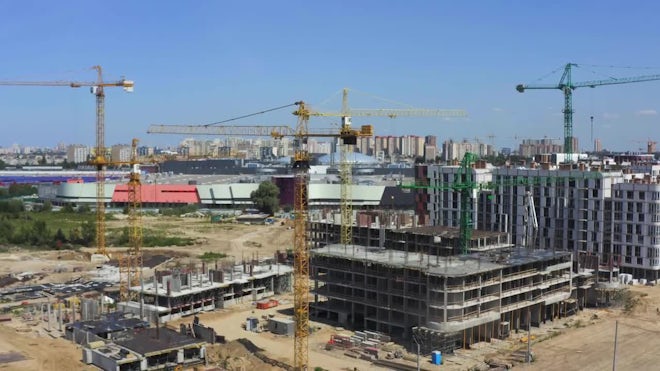Ever wondered what makes a building site tick? Discover the hidden rhythms and crucial stages of under construction projects that shape our skylines.
The Complex Symphony of Modern Construction Sites
Modern construction sites are intricate orchestrations of personnel, machinery, and materials working in perfect harmony. While passersby might see only chaos behind those familiar blue hoardings, every under construction project operates with military precision. In the UK, where construction contributes over £117 billion to the economy annually, these carefully choreographed operations transform architectural visions into reality. Each site follows a meticulously planned sequence, with different trades and specialists moving in a carefully timed dance that ensures efficiency, safety, and quality.
Ground Preparation and Foundation Stage
The success of any building under construction hinges on what happens below ground level. This crucial first phase sets the tone for the entire project, with thorough preparation being essential for long-term structural integrity. Recent data shows that 40% of construction delays stem from inadequate ground preparation, making this stage particularly critical.
Site Analysis and Ground Testing
- Detailed topographical surveys using advanced GPS technology
- Soil composition analysis and contamination testing
- Ground penetrating radar surveys for existing utilities
- Archaeological surveys (mandatory for UK urban developments)
- Environmental impact assessments
Foundation Systems and Groundworks
The foundation phase represents the literal groundwork of any construction project. UK building regulations require foundations to be designed according to specific soil conditions and building loads. Modern foundations often incorporate sustainable drainage systems (SuDS) and must account for increasingly extreme weather patterns. The choice between trench foundations, raft foundations, or piled foundations depends on various factors, including soil bearing capacity and building height.
The Structural Phase: Building the Core
As the building begins to rise from its foundations, the structural phase marks a significant milestone in the construction journey. This stage typically accounts for 30% of the total project timeline and requires precise coordination between multiple trades. The structural frame must be erected according to strict tolerances while maintaining site safety and efficiency.
Framework and Support Systems
- Steel frame installation with precision bolting techniques
- Reinforced concrete core construction
- Timber frame assembly for sustainable buildings
- Installation of temporary support systems
- Quality control checks at each structural level
Floor-by-Floor Construction
The vertical progression of a building under construction follows a methodical approach. Each floor must be completed to exacting standards before work can commence on the next level. Modern methods of construction (MMC) have revolutionised this process, with prefabricated elements reducing construction time by up to 30%.
Services Integration and Internal Works
The integration of building services represents one of the most complex phases of any construction project. Modern buildings require sophisticated networks of utilities and systems that must be carefully coordinated to avoid conflicts and ensure optimal performance.
Mechanical and Electrical Installation
- HVAC system installation and testing
- Electrical conduit and cable installation
- Plumbing and drainage systems
- Fire protection systems
- Smart building technology integration
Internal Fit-Out Processes
The internal fit-out transforms a shell into a functional space. This phase requires careful sequencing to ensure different trades can work efficiently without interference. Recent innovations in modular construction have streamlined this process, with pre-manufactured solutions reducing fit-out times by up to 50%.
Quality Control and Safety Measures
Quality control and safety are paramount in UK construction, with stringent regulations governing every aspect of building work. Sites under construction must maintain comprehensive safety protocols while ensuring the finished product meets all required standards.
Regular Inspections and Testing
- Daily site inspections by qualified supervisors
- Weekly safety audits and compliance checks
- Material testing and certification
- Building Control inspections at key stages
- Third-party quality assurance assessments
Site Safety Protocols
Construction sites in the UK must adhere to strict Health and Safety Executive (HSE) guidelines. Recent statistics show that sites implementing comprehensive safety protocols experience 75% fewer accidents than those with basic compliance measures.
Project Management and Coordination
Effective project management is the invisible force that keeps construction sites running smoothly. Modern construction management employs sophisticated digital tools and lean principles to optimise efficiency and reduce waste.
Timeline Management
- Critical path analysis and scheduling
- Resource allocation and tracking
- Progress monitoring and reporting
- Risk assessment and mitigation
- Change management procedures
Resource Allocation
Efficient resource management is crucial for keeping projects under construction on track and within budget. UK construction projects typically see a 15% improvement in efficiency when using integrated resource management systems.
Practical Insights for Success
Success in construction project management requires a combination of experience, technical knowledge, and practical problem-solving skills. Understanding common challenges and implementing proven solutions can significantly improve project outcomes.
Common Challenges and Solutions
- Weather-related delays and mitigation strategies
- Supply chain disruptions and alternative sourcing
- Labour shortage solutions
- Budget management techniques
- Stakeholder communication protocols
Best Practices for Efficient Site Management
Implementing best practices in site management can lead to significant improvements in project delivery. Studies show that sites following established best practices complete projects 20% faster and with fewer complications than those that don’t. Key considerations include early contractor involvement, regular team briefings, and the use of digital construction management tools.
FAQ
Is it illegal to go into a house under construction?
The property is not yours until closing, thus entering the property is technically trespassing.
What is construction slang?
Spark /sparky – an electrician, usually a skilled operative who is fully qualified to undertake the work. Spread – a plasterer. Steel fixer – someone who erects steel reinforcement for reinforced concrete structures. Tupper – a worker who carries the hod for a bricklayer. Waster – someone who does no or little work.
How do you use under construction in a sentence?
The space is now under construction and expected to be ready at the end of 2025. Two hundred of the projects are in the planning phase and 171 are under construction. The mega-project has cost more than $1 billion so far and has been under construction for more than a decade.
Why do we say “under construction”?
Where does under construction come from? Early instances of under construction come in legal contexts, drawing on a specialized use of construction to mean “interpretation” (e.g., under our construction of the terms of the contract).
What are the six types of construction?
Broadly, there are six types of construction projects: residential, commercial, institutional, mixed-use, industrial, and heavy civil.
Sources
[1] https://www.merriam-webster.com/dictionary/under%20construction
[2] https://underconstructioncc.com
[3] https://cuunderconstruction.com


Leave a Reply